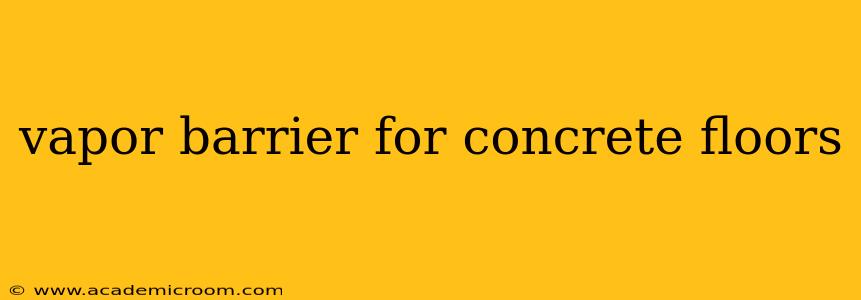Concrete floors, while durable and versatile, present a unique challenge: moisture vapor emission. This moisture can lead to a range of problems, from musty smells and mold growth to damage to flooring materials and even structural issues. A properly installed vapor barrier is crucial for mitigating these problems and ensuring a healthy, comfortable living or working space. This comprehensive guide will explore everything you need to know about vapor barriers for concrete floors.
What is a Vapor Barrier?
A vapor barrier is a material designed to impede the transmission of moisture vapor. In the context of concrete floors, it acts as a shield between the concrete slab and the overlying flooring materials, preventing moisture from rising and causing damage. Think of it as a raincoat for your floor, protecting it from the dampness below.
Why Use a Vapor Barrier Under Concrete Floors?
Several compelling reasons justify the use of a vapor barrier beneath concrete floors:
- Mold and Mildew Prevention: Moisture trapped between the concrete and flooring creates the perfect environment for mold and mildew growth, leading to health problems and structural damage. A vapor barrier effectively prevents this.
- Floor Damage: Excessive moisture can warp, buckle, or rot wood flooring, damage adhesives, and cause other issues with your floor coverings.
- Musty Odors: Dampness can lead to unpleasant musty odors that permeate the entire space.
- Improved Indoor Air Quality: By preventing moisture intrusion, a vapor barrier contributes to better indoor air quality, leading to a healthier living environment.
- Increased Longevity of Flooring: Protecting the flooring from moisture damage extends its lifespan, saving you money on repairs or replacements.
What are the Different Types of Vapor Barriers?
Several types of vapor barriers are suitable for use under concrete floors:
- Polyethylene Sheeting: This is a common and cost-effective option. It's readily available and easy to install, but it can be susceptible to tears and punctures.
- Polyurethane Membranes: Offering superior strength and durability compared to polyethylene, polyurethane membranes provide excellent moisture resistance.
- Asphalt-Based Emulsions: These are applied as a liquid coating, creating a continuous barrier. They're effective but require specialized application techniques.
- Vapor Retarding Coatings: These coatings are applied directly to the concrete slab and provide a measure of vapor resistance. They're often used in conjunction with other barriers for optimal protection.
How Much Vapor Barrier Do I Need?
The amount of vapor barrier needed depends entirely on the size of the area you're covering. Accurate measurements are crucial to ensure you purchase enough material without excessive waste. Remember to account for overlaps and waste when calculating your needs.
What are the Best Practices for Installing a Vapor Barrier?
Proper installation is key to the effectiveness of a vapor barrier. Here are some best practices:
- Clean Concrete Slab: Before installation, ensure the concrete slab is clean, dry, and free of debris.
- Overlap Seams: Overlap seams by at least 6 inches to create a continuous seal.
- Seal Edges: Seal edges carefully to prevent moisture from seeping in.
- Use Appropriate Tape: Use appropriate tape designed for the specific type of vapor barrier material.
- Proper Ventilation: Ensure adequate ventilation in the space to prevent moisture buildup.
What are the Signs of a Failing Vapor Barrier?
Several signs indicate a failing vapor barrier:
- Musty Smell: A persistent musty odor is a clear sign of moisture intrusion.
- Mold or Mildew Growth: Visible mold or mildew indicates a serious moisture problem.
- Buckling or Warping of Flooring: Damage to flooring materials points towards moisture damage.
- Peeling Paint: Moisture can cause paint to peel or blister.
Can I Install a Vapor Barrier Myself?
While installing a vapor barrier is a relatively straightforward DIY project, it requires careful attention to detail. If you're unsure of your abilities, it's always best to consult with a professional contractor to ensure proper installation.
How Much Does a Vapor Barrier Cost?
The cost of a vapor barrier varies depending on the type of material, the size of the area, and labor costs (if hiring a professional). Polyethylene sheeting is the most economical option, while more advanced materials like polyurethane membranes are more expensive.
Is a Vapor Barrier Necessary for All Concrete Floors?
Whether a vapor barrier is necessary depends on several factors, including climate, the type of flooring, and the moisture content of the concrete. In humid climates or when using moisture-sensitive flooring materials, a vapor barrier is highly recommended. Consult with a building professional for guidance specific to your situation.
By understanding the importance of vapor barriers and implementing the best installation practices, you can effectively protect your concrete floors and create a healthier, more comfortable environment. Remember, prevention is always better than cure when it comes to moisture damage.
